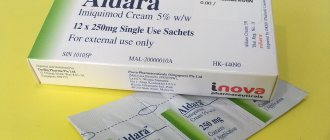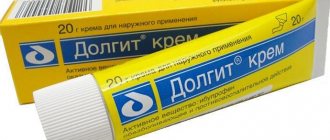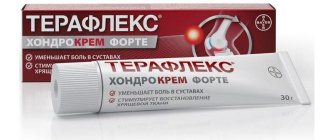Ovestin®
— To treat menopausal symptoms, HRT should only be started for symptoms that adversely affect quality of life. In all cases, a thorough assessment of the risks and benefits of treatment should be carried out at least once a year and HRT should be continued only as long as the benefits outweigh the risks.
-There is limited evidence of the risk development of HRT in the treatment of premature menopause. Because younger women have a lower absolute risk, their benefit-risk ratio is more favorable than that of older women.
Medical examination/observation
— Before starting or resuming HRT, it is necessary to obtain a detailed individual and family history. Guided by the obtained medical history, contraindications and warnings for the use of the drug, it is necessary to conduct a clinical examination, including examination of the pelvic organs and mammary glands. During treatment, it is recommended to conduct periodic medical examinations, the frequency and nature of which vary from person to person, but at least once a year. Women should be informed about the need to tell their doctor about changes in the mammary glands (see section “Breast cancer” below). Investigations, including appropriate imaging modalities such as mammography, should be performed in accordance with currently accepted screening standards and on a case-by-case basis.
Reasons for immediate discontinuation of therapy
Therapy should be discontinued if a contraindication is identified and if the following conditions occur:
- Jaundice or deterioration of liver function;
- Significant increase in blood pressure;
— The occurrence of migraine-type headaches;
- Pregnancy.
Endometrial hyperplasia and carcinoma
— To prevent stimulation of the endometrium, the daily dose of the drug should not exceed 1 application (0.5 mg estriol). This maximum dose should not be used for more than 4 weeks. In addition, one epidemiological study found that long-term use of low-dose estriol, administered orally but not intravaginally, may increase the risk of endometrial cancer. The risk increases with the duration of treatment and returns to baseline values one year after discontinuation of the drug. The risk of minimally invasive and well-differentiated tumors mainly increases. Vaginal bleeding in all cases requires examination. The patient should be informed of the need to contact the attending physician if vaginal bleeding begins.
Mammary cancer
— Hormone replacement therapy may increase mammographic density. This can make radiological detection of breast cancer more difficult. Clinical studies have shown that the likelihood of an increase in mammographic density is lower in women treated with estriol than in women treated with other estrogens.
-Composite evidence suggests an increased risk of breast cancer in women receiving combination therapy with estrogens and progestogens and possibly estrogen monotherapy.
-In women receiving combination therapy with estrogens and progestogens for more than 5 years, there was a 2-fold increase in the risk of breast cancer.
-With estrogen monotherapy, the increase in risk is significantly lower than when combined with progestogens.
-The level of risk depends on the duration of HRT.
— A similar risk is not known for the drug Ovestin®. A recent population-based case-control study of 3345 women with invasive breast cancer and 3454 controls showed that estriol use, unlike other estrogens, was not associated with an increased risk of breast cancer. It is therefore important that the risk of developing breast cancer is discussed with the patient and weighed against the known benefits of HRT.
Ovarian cancer
-Ovarian cancer develops much less frequently than breast cancer. Long-term estrogen monotherapy (at least 5–10 years) was associated with a small increase in the risk of ovarian cancer. Some studies suggest that combined HRT may increase the risk of ovarian cancer in a similar or small way. It is not known whether the risk of long-term use of low-potency estrogens (such as Ovestin®) differs from that of monotherapy with other estrogens.
Venous thromboembolism
— HRT is associated with an increased risk of developing venous thromboembolism (VTE), i.e. deep vein thrombosis or pulmonary embolism, 1.3-3 times. The likelihood of developing VTE is higher during the first year of HRT use than at a later date. A similar risk is not known for Ovestin®.
-In patients with confirmed thrombophilia, the risk of VTE is high, and HRT may further increase it. In this regard, HRT is contraindicated for such women (see section “Contraindications”).
— Commonly recognized risk factors for VTE include estrogen use, older age, major surgery, prolonged immobilization, obesity (BMI >30 kg/m2), pregnancy/puerperium, systemic lupus erythematosus and cancer. There is no consensus regarding the possible role of varicose veins in the development of VTE. After any surgical intervention, VTE prophylaxis is necessary. If prolonged immobilization is associated with elective surgery, it is necessary to temporarily discontinue HRT 4-6 weeks before surgery. Treatment should be resumed after the woman begins to walk.
— For women already receiving anticoagulant treatment, careful consideration of the benefit-risk ratio of HRT is required.
-If the drug Ovestin® is prescribed as “pre- and postoperative treatment...”, the issue of thrombosis prophylaxis should be considered.
-In the absence of a history of VTE, but in the presence of thrombosis at a young age in the patient’s closest relatives, she can be offered a screening examination, having previously discussed all its limitations (screening can only identify a number of thrombophilic disorders). If a thrombophilic defect is detected that does not correspond to the disease in relatives, or if a “severe” defect is detected (for example, deficiency of antithrombin, protein S or protein C, or a combination of these defects), HRT is contraindicated.
— If VTE develops after starting treatment with Ovestin®, then treatment should be stopped. Patients should be informed to seek immediate medical attention if they experience possible signs of thromboembolism (eg, painful leg swelling, sudden chest pain, shortness of breath).
Coronary heart disease (CHD)
-In randomized controlled trials, there were no results that would indicate that combination therapy with estrogens and progestogens and estrogen monotherapy can prevent the development of myocardial infarction in women with and without coronary artery disease.
Estrogen monotherapy
— According to randomized controlled trials in women with a removed uterus, the risk of coronary heart disease does not increase with estrogen monotherapy.
-The risk of coronary heart disease increases slightly with combined HRT with estrogens and progestogens in patients over 60 years of age.
Ischemic stroke
-Combination therapy with estrogens and progestogens and monotherapy with estrogens are associated with a 1.5-fold increase in the risk of ischemic stroke. The relative risk does not change with age or time after menopause. However, the baseline risk of stroke is highly dependent on age, and the overall risk of stroke with HRT increases with age. The risk of hemorrhagic stroke does not increase with HRT.
Other states
- Estrogens can cause fluid retention, and therefore patients with impaired renal function and cardiovascular insufficiency should be closely monitored.
— Estriol is a weak gonadotropin antagonist and does not have other significant effects on the endocrine system.
— Cognitive function does not improve with HRT. Evidence was obtained of an increased risk of developing dementia in women who began using combination therapy or monotherapy in a continuous regimen after 65 years.
The drug contains cetyl alcohol and stearic alcohol, which can cause local skin reactions (for example, contact dermatitis).
Ovestin, cream 1 mg/g, 15 g
Manufacturer
Aspen Bad Oldesloe GmbH, Germany
Compound
Active substance:
Estriol 1 mg/g.
Excipients:
Octyldodecanol 50.0 mg, cetyl palmitate 15.0 mg, glycerol 120.0 mg, cetyl alcohol 36.7 mg, stearyl alcohol 88.4 mg, polysorbate 60 32.4 mg, sorbitan stearate 7.6 mg, lactic acid 4, 0 mg, chlorhexidine dihydrochloride 0.1 mg, sodium hydroxide to pH 4.0, purified water to 1000.0 mg
pharmachologic effect
The drug Ovestin® contains estriol, an analogue of the natural female hormone. It replenishes estrogen deficiency in postmenopausal women and reduces postmenopausal symptoms. Estriol is most effective in the treatment of genitourinary disorders. In case of atrophy of the mucous membrane of the lower parts of the genitourinary tract, estriol helps to normalize the epithelium of the genitourinary tract and helps restore normal microflora and physiological pH in the vagina.
As a result, it increases the resistance of epithelial cells of the genitourinary tract to infection and inflammation, reducing complaints such as pain during sexual intercourse, dryness, itching in the vagina, reduces the likelihood of vaginal infections and urinary tract infections, helps normalize urination and prevents urinary incontinence.
Unlike other estrogens, estriol has a short period of action, since it is retained in the nuclei of endometrial cells for a short period of time. It is assumed that a single daily dose does not cause endometrial proliferation. Therefore, cyclic administration of progestogen is not required and withdrawal bleeding does not occur. In addition, estriol has not been shown to increase mammographic density.
Pharmacokinetics
Intravaginal administration of estriol ensures optimal bioavailability at the site of action. Estriol is also absorbed and enters the general bloodstream, which is manifested by a rapid increase in the concentration of unbound estriol in plasma. The maximum concentration in plasma is observed 1-2 hours after administration.
In plasma, almost all (90%) estriol is associated with albumin and, unlike other estrogens, is practically not associated with sex hormone-binding globulin. The metabolism of estriol consists mainly of the transition to a conjugated and unconjugated state during the enterohepatic circulation. Estriol, being the end product of metabolism, is mainly excreted in the urine in bound form.
Only a small portion (±2%) is excreted in the feces, mainly as unbound estriol. The half-life is approximately 6-9 hours. After vaginal administration of 0.5 mg estriol, the maximum concentration of Cmax is approximately 100 pg/ml, the minimum concentration of Cmin is approximately 25 pg/ml, and the average concentration of Cav is approximately 70 pg/ml. After 3 weeks of daily application of 0.5 mg vaginal estriol, the Cav value decreased to 40 pg/ml.
Indications
• Hormone replacement therapy (HRT) for the treatment of mucosal atrophy of the lower genitourinary tract associated with estrogen deficiency in postmenopausal women. • Pre- and postoperative therapy for postmenopausal women during surgical interventions with vaginal access. • As an auxiliary diagnostic tool when obtaining an atrophic picture of a cervical smear.
Contraindications
- Known, known or suspected breast cancer.
- Diagnosed or suspected estrogen-dependent tumors (for example, endometrial cancer).
- Bleeding from the vagina of unknown etiology.
- Untreated endometrial hyperplasia.
- The presence of venous thrombosis currently and in history (deep vein thrombosis, pulmonary thromboembolism).
- Confirmed thrombophilias (eg, protein C, protein S, or antithrombin deficiency).
- Thrombosis (venous and arterial) and thromboembolism currently or in history (including deep vein thrombosis, pulmonary embolism, myocardial infarction, stroke), cerebrovascular disorders; conditions preceding thrombosis (including transient ischemic attacks, angina) currently or in history.
- Acute liver disease or a history of liver disease after which liver function tests have not returned to normal.
- Established hypersensitivity to the active substance or to any of the excipients of the drug.
- Porphyria.
With caution With caution (under close medical supervision), Ovestin® should be used if any of the following diseases or conditions are present, or these diseases or conditions have been noted previously and/or worsened during previous pregnancies or previous hormonal treatment (since they may recur or worsen during treatment with Ovestin®: − Leiomyoma (uterine fibroids) or endometriosis. − Risk factors for thromboembolism − Risk factors for estrogen-dependent tumors, for example, 1st degree of heredity for breast cancer. − Arterial hypertension. − Benign liver tumors (for example, liver adenoma). − Diabetes mellitus with or without diabetic angiopathy. − Gallstone disease. − Jaundice (including a history during a previous pregnancy). − Liver failure. − Migraine or (severe) headache. − Systemic lupus erythematosus. − History of endometrial hyperplasia. − Epilepsy. − Bronchial asthma. − Otosclerosis. − Familial hyperlipoproteinemia. − Pancreatitis. With caution With caution (under close medical supervision), Ovestin® should be used if any of the following diseases or conditions are present, or these diseases or conditions have been noted previously and/or worsened during previous pregnancies or previous hormonal treatment (since they may recur or worsen during treatment with Ovestin®: − Leiomyoma (uterine fibroids) or endometriosis. − Risk factors for thromboembolism − Risk factors for estrogen-dependent tumors, for example, 1st degree of heredity for breast cancer. − Arterial hypertension. − Benign liver tumors (for example, liver adenoma). − Diabetes mellitus with or without diabetic angiopathy. − Gallstone disease. − Jaundice (including a history during a previous pregnancy). − Liver failure. − Migraine or (severe) headache. − Systemic lupus erythematosus. − History of endometrial hyperplasia. − Epilepsy. − Bronchial asthma. − Otosclerosis. − Familial hyperlipoproteinemia. − Pancreatitis.
Side effects
As with any other drug that is applied to the surface of the mucous membranes, Ovestin® cream can sometimes cause local irritation or itching. Sometimes there may be tension, soreness, sensitivity and enlargement of the mammary glands. These adverse reactions are usually short-lived and transient, but at the same time may indicate the use of too high a dose.
Also found: acyclic spotting, breakthrough bleeding, metrorrhagia. Other adverse reactions have been reported during estrogen monotherapy or combination therapy with estrogens and progestogens.
Disorders of the liver and biliary tract:
− Gallstone disease.
Benign, malignant and unspecified neoplasms (including cysts and polyps):
− Benign and malignant estrogen-dependent neoplasia, incl. endometrial cancer.
Mental disorders:
− Dementia when starting continuous HRT after 65 years.
Disorders of the genital organs and breast:
− Increased libido.
Disorders of the skin and subcutaneous tissues:
− Chloasma, erythema multiforme, erythema nodosum, hemorrhagic purpura.
There is data on the development of the risk of breast cancer, ovarian cancer, and the risk of venous cancer.
Interaction
In clinical practice, no interaction has been observed between the drug Ovestin® and other drugs.
The metabolism of estrogens may be enhanced when used in combination with compounds that induce enzymes involved in drug metabolism, particularly cytochrome P450 enzymes, such as anticonvulsants (e.g., phenobarbital, phenytoin, carbamazepine) and antimicrobials (e.g., rifampicin, rifabutin, nevirapine, efavirenz).
Ritonavir and nelfinavir exhibit inducing properties when used in combination with steroid hormones. Herbal preparations containing St. John's wort (Hypericum perforatum) may induce estrogen metabolism. Increased metabolism of estrogens may lead to a decrease in their clinical effect.
Estriol enhances the effect of lipid-lowering drugs, weakens the effects of male sex hormones, anticoagulants, antidepressants, diuretics, hypotensive, hypoglycemic drugs.
Medicines for general anesthesia, narcotic analgesics, anxiolytics, some antihypertensive drugs, ethanol reduce the effectiveness of the drug.
Folic acid and thyroid medications enhance the effect of estriol.
How to take, course of administration and dosage
Ovestin® cream should be inserted into the vagina using a calibrated applicator at night before bed. 1 application (applicator filled to the ring mark) contains 0.5 g of cream, which corresponds to 0.5 mg of estriol. • In the treatment of atrophy of the mucous membrane of the lower genitourinary tract: • 1 application per day for the first weeks (maximum 4 weeks), followed by a gradual reduction in dose, based on the dynamics of symptoms, until a maintenance dose is reached (i.e. 1 administration twice a day). week). • Pre- and postoperative therapy for postmenopausal women during surgical interventions via vaginal access: • 1 application per day for 2 weeks before surgery; 1 application twice a week for 2 weeks after surgery. • For diagnostic purposes in case of unclear results of cytological examination of the cervix: 1 application every other day for a week before taking the next smear. Instructions for use for patients 1. The cream is inserted into the vagina at night before bed. 2. Remove the cap from the tube, turn the cap over and use a sharp rod to open the tube. 3. Screw the applicator onto the tube. 4. Squeeze the tube to fill the applicator with cream until the piston stops. 5. Unscrew the applicator from the tube and close the tube with the cap. 6. In the “lying down” position, the cream is injected, the end of the applicator is inserted deep into the vagina and slowly press the piston until it stops. After administering the drug, remove the piston from the cylinder and wash the cylinder and piston with warm water and soap. Detergents should not be used. After which the cylinder and piston are rinsed abundantly with clean water. DO NOT INCLUDE THE APPLICATOR IN HOT OR BOILING WATER. The missed dose should be administered on the same day as soon as the patient remembers (the dose should not be administered twice a day). Subsequent applications are carried out in accordance with the usual dosage regimen. When initiating or continuing treatment of menopausal symptoms, the lowest effective dose should be used for the shortest period of time. In women not receiving HRT, or women who are switching from continuous oral combination therapy to HRT, treatment with Ovestin® cream can be started on any day. Women who are switching from a cyclic regimen of HRT medications should begin treatment with Ovestin® cream one week after stopping HRT medications.
Overdose
The acute toxicity of estriol in animals is very low. An overdose of Ovestin® when administered vaginally is unlikely. However, if large quantities enter the gastrointestinal tract, nausea, vomiting and bleeding cessation may occur in women. A specific antidote is unknown. If necessary, symptomatic treatment should be carried out.
Special instructions
• To treat menopausal symptoms, HRT should only be started for symptoms that adversely affect quality of life. In all cases, a thorough assessment of the risks and benefits of treatment should be carried out at least once a year and HRT should be continued only as long as the benefits outweigh the risks.
• There is limited evidence of the risk of HRT when treating premature menopause. Because younger women have a lower absolute risk, their benefit-risk ratio is more favorable than that of older women.
Medical examination/observation
• Before starting or resuming HRT, a detailed individual and family history should be obtained. Guided by the obtained medical history, contraindications and warnings for the use of the drug, it is necessary to conduct a clinical examination, including examination of the pelvic organs of the mammary glands. During treatment, it is recommended to conduct medical examinations, the frequency and nature of which vary from person to person, but at least once a year. Women should be informed about the need to report changes in the mammary glands to their doctor.
Investigations, including appropriate imaging modalities such as mammography, should be performed in accordance with currently accepted screening standards and on a case-by-case basis.
Reasons for immediate discontinuation of therapy
Therapy should be discontinued if a contraindication is identified and if the following conditions occur:
• Jaundice or deterioration of liver function.
• Significant increase in blood pressure.
• The occurrence of migraine-type headaches.
• Pregnancy.
Endometrial hyperplasia and carcinoma
• To prevent stimulation of the endometrium, the daily dose of the drug should not exceed 1 application (0.5 mg estriol). This maximum dose should not be used for more than 4 weeks. In addition, one epidemiological study found that long-term use of low-dose estriol, administered orally but not intravaginally, may increase the risk of endometrial cancer. The risk increases with the duration of treatment and returns to baseline values one year after discontinuation of the drug. The risk of minimally invasive and well-differentiated tumors mainly increases. Vaginal bleeding in all cases requires examination. The patient should be informed of the need to contact the attending physician if vaginal bleeding begins.
Mammary cancer
• Hormone replacement therapy may increase mammographic density. This can make radiological detection of breast cancer more difficult. Clinical studies have shown that the likelihood of an increase in mammographic density is lower in women treated with estriol than in women treated with other estrogens.
• Consolidated evidence suggests an increased risk of breast cancer in women receiving combination therapy with estrogens and progestogens and possibly estrogen monotherapy.
• In women receiving combination therapy with estrogens and progestogens for more than 5 years, a 2-fold increase in the risk of breast cancer was noted.
• With estrogen monotherapy, the increase in risk is significantly lower than when combined with progestogens.
• The level of risk depends on the duration of HRT.
• No such risk is known for Ovestin®. A recent population-based case-control study of 3345 women with invasive breast cancer and 3454 controls showed that estriol use, unlike other estrogens, was not associated with an increased risk of breast cancer. It is therefore important that the risk of developing breast cancer is discussed with the patient and weighed against the known benefits of HRT.
Ovarian cancer
• Ovarian cancer develops much less frequently than breast cancer. Long-term estrogen monotherapy (at least 5–10 years) was associated with a small increase in the risk of ovarian cancer. Some studies suggest that combined HRT may increase the risk of ovarian cancer in a similar or small way. It is not known whether the risk of long-term use of low-potency estrogens (such as Ovestin®) differs from that of monotherapy with other estrogens.
Venous thromboembolism • HRT is associated with an increased risk of venous thromboembolism (VTE), i.e. deep vein thrombosis or pulmonary embolism, 1.3 – 3 times. The likelihood of developing VTE is higher during the first year of HRT use than at a later date. A similar risk is not known for Ovestin®. • In patients with confirmed thrombophilia, the risk of VTE is high, and HRT may further increase this risk. In this regard, HRT is contraindicated for such women. • Commonly recognized risk factors for VTE include estrogen use, older age, major surgery, prolonged immobilization, obesity (BMI > 30 kg/m2), pregnancy/puerperium, systemic lupus erythematosus, and cancer. There is no consensus regarding the possible role of varicose veins in the development of VTE. After any surgical intervention, VTE prophylaxis is necessary. If prolonged immobilization is associated with elective surgery, it is necessary to temporarily discontinue HRT 4–6 weeks before surgery. Treatment should be resumed after the woman begins to walk. • For women already receiving anticoagulant treatment, careful consideration of the benefit-risk balance of HRT is required. • If Ovestin® is prescribed as “pre- and postoperative treatment...”, the issue of thrombosis prophylaxis should be considered. • In the absence of a history of VTE, but in the presence of thrombosis at a young age in the patient’s closest relatives, she can be offered a screening examination, having previously discussed all its limitations (screening can only detect a number of thrombophilic disorders). If a thrombophilic defect is detected that does not correspond to the disease in relatives, or if a “severe” defect is detected (for example, deficiency of antithrombin, protein S or protein C, or a combination of these defects), HRT is contraindicated. • If VTE develops after starting treatment with Ovestin®, treatment should be discontinued. Patients should be informed to seek immediate medical attention if they experience possible signs of thromboembolism (eg, painful leg swelling, sudden chest pain, shortness of breath). Coronary heart disease (CHD) • Randomized controlled trials have not provided evidence that combination therapy with estrogens and progestogens and estrogen monotherapy can prevent the development of myocardial infarction in women with and without CAD. Estrogen monotherapy: − According to randomized controlled trials in women with a removed uterus, the risk of coronary heart disease does not increase with estrogen monotherapy. • The risk of coronary heart disease increases slightly with combined HRT with estrogens and progestogens in patients over 60 years of age. Ischemic stroke • Combination therapy with estrogens and progestogens and estrogen monotherapy are associated with a 1.5-fold increase in the risk of ischemic stroke. The relative risk does not change with age or time after menopause. However, the baseline risk of stroke is highly dependent on age, and the overall risk of stroke with HRT increases with age. The risk of hemorrhagic stroke does not increase with HRT. Other Conditions • Estrogens may cause fluid retention and therefore patients with renal impairment and cardiovascular insufficiency should be closely monitored. • Estriol is a weak gonadotropin antagonist and has no other significant effects on the endocrine system. • Cognitive function does not improve with HRT. Evidence was obtained of an increased risk of developing dementia in women who began using combination therapy or monotherapy in a continuous regimen after 65 years. The drug contains cetyl alcohol and stearyl alcohol, which can cause local skin reactions (for example, contact dermatitis). Effect on the ability to drive vehicles and operate machinery. No effect of the drug Ovestin® on concentration and attention was noted.
Release form
Vaginal cream 1 mg/1 g. 15 g of cream is placed in an aluminum tube, closed with a screw-on polyethylene cap. A tube with an applicator consisting of a styrene acrylonitrile cylinder and a polyethylene piston, and instructions for use are placed in a cardboard box.
Storage conditions
Store at temperatures between 2 °C and 25 °C. Do not freeze. Keep out of the reach of children.
Best before date
3 years. Do not use after expiration date.
Active substance
Estriol
Dosage form
cream
Purpose
For postmenopausal women
Indications
Estrogen deficiency
Barcode and weight
Barcode: 5060249172604, 4601909000045 Weight: 0.038 kg




